Want to know the secret to bigger, stronger arms without ever stepping foot in a gym?
I get it. Over the last ten years, I’ve tried hundreds of arm exercises and found some of the best ones for building triceps only with bodyweight.
In this guide, I share 12 bodyweight triceps exercises that deliver the best results.
Let’s build BIGGER triceps.

- Bodyweight Triceps Exercises
- 1. Bench Dip
- 2. Diamond Push Up
- 3. Kneeling Bodyweight Tricep Extension
- 4. Parallel Bar Triceps Dip
- 5. Close Grip Push Up
- 6. Plank to Push Up
- 7. Hindu Push Up
- 8. Stability Ball Push Up
- 9. Medicine Ball Push-Up
- 10. Pike Push Up
- 11. Handstand Push Up
- 12. Weighted Push Up
- Beginner Bodyweight Tricep Workout Routine
- Tricep Workout Routine For Intermediate
- Conclusion
- Reference
Bodyweight Triceps Exercises
Below, you will find the 12 best bodyweight triceps exercises to help you build stronger and bigger triceps.
1. Bench Dip
The bench dip exercise is one of the most basic and best workouts for building bigger arms. It’s an effective exercise for building triceps. It also targets the shoulders (particularly the anterior delt heads), chest (pectorals), and serratus anterior.
This workout is excellent for people just starting to get into shape and for advanced athletes who want to burn fat.
The bench dip’s beauty lies in its simplicity, accessibility, and targeted activation of the triceps—specifically, the long and lateral heads.
The following are the best Bench Dip variations to try:
- Bent-Knee Bench Dip (Beginner-Friendly): Feet flat on the floor with knees bent at 90°. Reduce the load on your triceps.
- Straight-Leg Bench Dip (Intermediate Level): Legs extended straight out in front with heels on the ground. Increases resistance via full bodyweight
- Elevated Feet Bench Dip (Advanced Bodyweight): The feet are elevated on a second bench or box, placing more load on the arms.
- Weighted Bench Dip (Max Strength & Hypertrophy): Add a weight plate, dumbbell, or weighted vest to your lap.
- Single-Leg Bench Dip (Balance + Unilateral Challenge): Perform with one leg raised while the other supports your body.
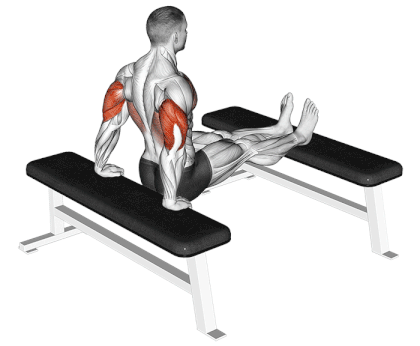
How To Do
- Place your hands on the side of a flat bench so that your body is perpendicular to the bench when you place your feet out in front of you.
- Sit on one bench and place your feet on the edge of the other so your legs are suspended between the two.
- Your arms should be fully extended with your palms on the bench.
- Bend your elbows to lower your body down until your elbows reach 90 degrees.
- Do not dip down too low, as it places unnecessary strain on the shoulder joints.
- Now, lift your body back up using your arms and flexing your triceps at the top.
2. Diamond Push Up
Diamond push-ups are a more advanced variation of classic push-ups. They provide all the benefits of a normal push-up, with a special focus on the triceps and inner chest.
The narrow hand position forces a greater degree of elbow flexion and extension under load, hammering all three heads of the triceps.
During my early training, I did lots of diamond push-ups and close-grip push-ups, which helped me build bigger triceps.
There is a variation for everyone, from novices to advanced athletes:
- Knee Diamond Push-Up (Beginner-Friendly): Performed on your knees, reducing the load on the upper body.
- Feet-Elevated Diamond Push-Up (Advanced): The feet are placed on a bench or box, increasing the angle and intensity.
- Explosive/Plyometric Diamond Push-Up (Power & Speed): Push explosively off the floor so your hands leave the ground.
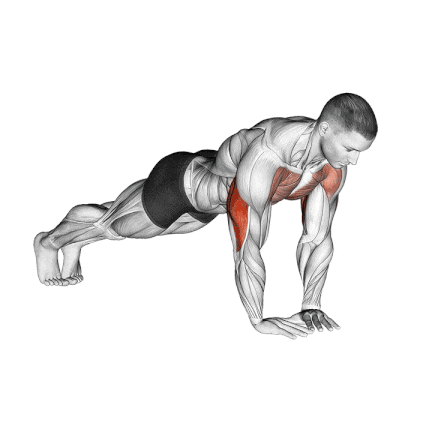
How To Do
- Start in a high plank position (top of a push-up).
- Form a triangle or diamond shape with your hands by bringing them together just under your chest so that your thumbs and index fingers meet.
- Your body should form a straight line from your head to your heels. Engage your glutes and core to prevent your hips from sagging or piking.
- Shoulders should be directly over your wrists (or slightly behind to help with elbow tracking).
- Keep your core tight and body straight, and slowly lower until your chest is very close to your hands.
- Your elbows should track backwards, close to your ribcage. Do NOT let them flare out to the sides.
- Press hard through your palms while extending your elbows to get your body back to the starting position..
- Focus on squeezing your triceps and chest as you push.
3. Kneeling Bodyweight Tricep Extension
The kneeling bodyweight triceps extension (sometimes called a bodyweight skullcrusher) may look simple, but it delivers a deep, targeted burn that rivals cable pushdowns or overhead extensions.
It is one of the best exercises for isolating your triceps without dumbbells, barbells, or weight machines.
To make it more difficult, you can either move your knees backwards or lean forward so that more of your body weight is over your hands.
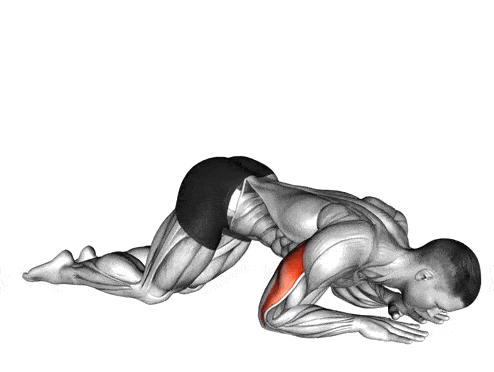
How To Do
- Kneel on a mat or soft surface, with your knees about hip-width apart.
- Place your hands on the floor in front of you, shoulder-width apart, palms flat, fingers pointing forward.
- Walk your hands forward until your body forms a straight line from your head, through your shoulders and hips, down to your knees.
- Keep your body in that straight line (no piking at the hips, no sagging), and slowly lower your upper body towards the floor by bending ONLY at your elbows.
- Keep your elbows tucked into your body. Do not flare them out.
- Push your upper body back up to the starting position by powerfully extending your elbows and pressing through your palms.
4. Parallel Bar Triceps Dip
Parallel bar triceps dip is one of the most effective bodyweight exercises. It primarily targets the triceps brachii muscles and your chest, shoulders, and core.
It is one of my favorite exercises, which I must do during my push workout routines.
You can adjust the difficulty of dips by changing your body position, adding weight, or using different variations.
- For example, you can lean your torso forward to target your chest more.
- Keep your body upright for a more triceps-focused workout.
- You can also add weight using a dip belt or a backpack filled with weights.
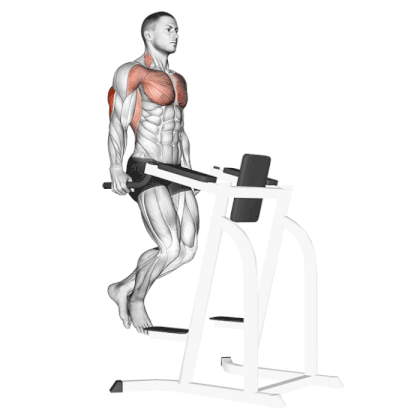
How To Do
- Grasp the dip bars with your arms extended and locked.
- Keep your body as vertical as possible to keep the emphasis on the triceps and away from the chest.
- Keep your elbows as close to your sides as possible as you bend them to lower your body down until your upper arms are about parallel to the floor.
- Press your hands forcefully into the bars to extend your arms and raise your body back up.
- Repeat for the recommended number of repetitions.
5. Close Grip Push Up
Close-grip push-ups are among the best ways to build strength and muscle mass in the inner chest and triceps.
A study found greater electromyographic (EMG) activity in the triceps brachii during close push-ups than during regular push-ups.
If you find standard close-grip push-ups difficult, try doing them with your knees on the ground until your strength increases.
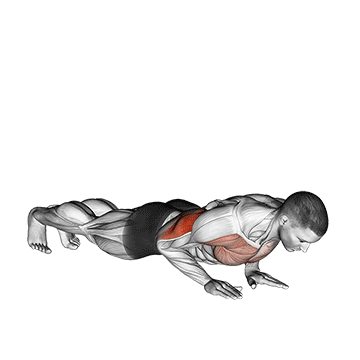
How To Do
- Start by lying face down on the ground, legs extended, and feet together.
- Make sure your heels are directly over your toes, and your wrists are still under your shoulders, closer together than in a standard push-up position.
- Your neck should align with your spine (don’t lift your chin or head), and your shoulders should be pulled back and down, away from your ears.
- Keep your body straight from head to toe by engaging your core.
- Bend your elbows at a 45-degree angle out to the sides and lower yourself toward the floor.
- Now, raise yourself off the ground. Press through your palms, using your triceps and chest to lift yourself back to the starting position.
- Once you have risen, give yourself a mental high-five and hold it briefly. Feel those muscles working? That’s the sound of progress, my friend.
- Repeats.
6. Plank to Push Up
The Plank to Push-up, also known as the Plank push-up, combines the two exercises (Plank and Push-up) that provide both benefits.
It is a brilliant bodyweight exercise that helps you develop the strength and stability of your tricep, core and upper body.
How To Do
- Begin in a standard forearm plank position. Your elbows should be directly under your shoulders, and your forearms should be parallel.
- Your body should form a straight line from your head to your heels. Engage your glutes and core firmly.
- Lift one arm and put the flat hand right where your elbow was on the floor.
- Press through that hand, and simultaneously lift your other arm, placing that hand flat on the floor where its elbow is. You are now in a high plank (top of a push-up) position, with hands directly under shoulders.
- Lower back down onto the forearm of the same arm that initiated the upward movement. Place the elbow where the hand was.
- Then, lower the other arm to its forearm to get back to the initial forearm plank position.
- On the next repetition, initiate the ascent with the opposite arm to ensure balanced development.
7. Hindu Push Up
The Hindu push-up, also known as a “Dhand” , is a bodyweight exercise that targets the shoulders, chest, triceps, and core and back muscles.
It is a dynamic exercise combining yoga and traditional push-ups to create a more challenging shoulder workout.
It provides better muscle strength and endurance. It is a complete exercise that has a compound effect on the body.

How To Do
- Start in a downward dog pose, with your hands shoulder-width apart, your body in a V shape.
- Engage your core, relax the spine and neck, open the shoulders and keep the movement smooth.
- Bend your elbows and lower your chest until it’s just above the floor.
- In a scooping motion, lift your head upward while arching your lower and upper back, then go into cobra pose.
- Return to the starting position, you do not need to reverse back through the sweeping, arching motion.
- Push back into the starting position.
8. Stability Ball Push Up
The study found that the Triceps brachii sEMG activity was higher during Swiss ball hands than on a stable surface.
Using a Swiss ball (or exercise ball) can bring an extra element to pushups, giving you an uneven surface to increase the difficulty.
When you do push-ups with your hands on a stability ball, your triceps brachii muscles work more.
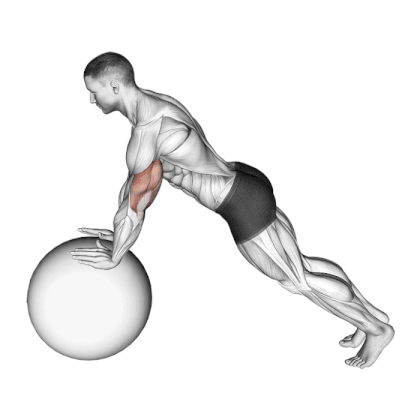
How To Do
- Lay on the stability ball with your chest on it. Place your hands on the ball at the sides of your chest.
- Place your feet back and lean forward so that your chest is directly over the ball and you are supported on your toes.
- Keep your glutes and core muscles contracted.
- Your neck should be aligned with your body, not tilted up, which could strain the neck.
- Push your body until your arms are almost straight (do not lock your elbows). Pause here for a second.
- Breathe and extend your arms to bring your upper body back to the starting position.
9. Medicine Ball Push-Up
If you’re looking to challenge your triceps, shoulders, and core in a single move, without adding external load, the Medicine Ball Push-Up is a must-have in your bodyweight arsenal.
The unstable surface forces your triceps and shoulder stabilizers to work harder than traditional push-ups. It also helps improve core strength and stability.

How To Do
- Place the medicine ball on the floor in front of you.
- Carefully place both hands onto the medicine ball. Your hands will be very close together, similar to a diamond or close-grip push-up.
- Your body should form a perfectly straight line from your head through your shoulders, hips, and knees down to your heels.
- Brace your core tightly (as if expecting a punch) and squeeze your glutes. This is non-negotiable for stability.
- Inhale, and then slowly begin to lower your chest towards the medicine ball.
- You will feel the ball wanting to wobble. Use your core, shoulders, and triceps to control this.
- Exhale, and then press through your palm while extending your elbows to get back to the high plank position you started in.
10. Pike Push Up
Pike Push-ups are a variation of the push-up that increases strength and stability in the shoulders and triceps.
The hands are approximately 1-1.5x shoulder width, and the head aligns with a neutral spine.
Pike push up is a reasonably advanced movement that requires extra attention to form and quality over quantity.
It is important to have enough general mobility before attempting any exercise, and beginners should start with classic push-ups before transitioning to pike push-ups.
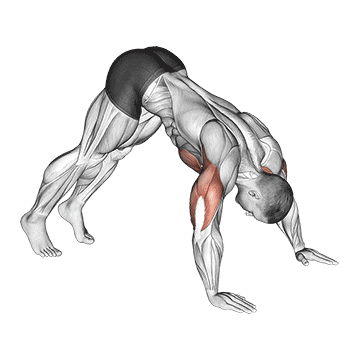
How To Do
- Start in a standard push-up position with your hands slightly wider than shoulder-width apart and elbows completely locked out.
- Lift the hips up and back until your body forms an inverted V shape.
- Keep your arms and legs as straight as you possibly can.
- Slowly lower the top of your head towards the ground.
- Once your head is about to contact the ground, pause for a second.
- Never let your head touch the floor, but try to get as close to it as possible.
- Then slowly push back until your arms are straight, and you’re in the inverted V position.
11. Handstand Push Up
The handstand push-up, also known as the vertical push-up, is a type of push-up exercise in which the body is positioned in a handstand.
It is an advanced bodyweight exercise that targets the shoulders, arms, and core.
They require high upper body strength and skill and should be attempted only after proper training and conditioning.
To prepare for the strength until one has built adequate balance, the feet are often placed against a wall, held by a partner, or secured in some other way from falling.
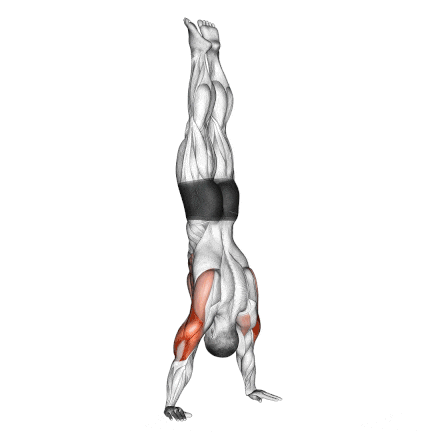
How To Do
- Start in a handstand position against a wall, with your hands placed on the ground and your body in a straight line.
- Slowly lower your body towards the ground by bending your arms, keeping your body straight.
- Push your body back up to the starting position by extending your arms.
- When attempting this exercise, it is important to have a spotter or use a wall for safety and support.
12. Weighted Push Up
Weighted push-ups are not just another chest exercise or something you would do at the end of the chest training days to enjoy the pump. They are an important strengthening exercise for the triceps.
Weighted pushups can have numerous benefits, such as a massive chest, a stronger core, stronger arms, and improved testosterone naturally. They transform the body into a fat-burning furnace.

How To Do
- Get in the standard push-up position with your hands slightly wider than shoulder-width apart.
- Have a partner load a weight plate onto your back.
- Make sure to keep your elbows tucked in close by your sides.
- Once your chest touches the ground, pause, then press back up to the starting position.
Beginner Bodyweight Tricep Workout Routine
| Exercise | Sets | Repetitions |
|---|---|---|
| Knee Diamond Push-Ups | 3-4 | 8-10 |
| Bodyweight Triceps Extension | 3-4 | 8 |
| Bench Dips | 4 | 8-10 |
Tricep Workout Routine For Intermediate
| Exercise | Sets | Repetitions |
|---|---|---|
| Diamond Push-Ups | 4 | 8-10 |
| Bench Dips with Elevated Legs | 3-4 | 10-12 |
| Parallel Bar Triceps Dip | 4 | 10-12 |
| Plank To Push-Up | 3 | 8-10 |
Conclusion
Exercises such as diamond push-ups, close-grip push-ups, and bench dips with elevated legs can help to improve arm and upper body strength, increase muscle endurance, and achieve a more toned physique.
Be smart: Don’t limit yourself to bodyweight tricep exercises. Take advantage of their benefits and supplement them with other tricep exercises when needed.
- Triceps Workout With Dumbbells
- Barbell Triceps Exercises
- Triceps Cable Exercises For Building Bigger Arms
A bodyweight workout can be easily incorporated into any training program. It can be particularly effective when used alongside dumbbells, barbells, machines, and cables to build the most prominent, strongest tricep possible.
If done consistently, the results will speak for themselves.
Thanks for reading; enjoy your workout!
Reference
- Dhahbi W, Chaabene H, Chaouachi A, Padulo J, Behm DG, Cochrane J, Burnett A, Chamari K. Kinetic analysis of push-up exercises: a systematic review with practical recommendations. Sports Biomech. 2022 Jan;21(1):1-40.
- Cogley RM, Archambault TA, Fibeger JF, Koverman MM, Youdas JW, Hollman JH. Comparison of muscle activation using various hand positions during the push-up exercise. J Strength Cond Res. 2005 Aug;19(3):628-33. doi: 10.1519/15094.1. PMID: 16095413.
- Bezerra, E. D. S., Orssatto, L. B. D. R., Werlang, L. C., Generoso, A. M., Moraes, G., & Sakugawa, R. L. (2020). Effect of push-up variations performed with Swiss ball on muscle electromyographic amplitude in trained men: A cross-sectional study. Journal of Bodywork and Movement Therapies, 24(2), 74-78. https://doi.org/10.1016/j.jbmt.2019.09.004

Manish is a NASM-certified fitness and nutrition coach with over 10 years of experience in weight lifting and fat loss fitness coaching. He specializes in gym-based training and has a lot of knowledge about exercise, lifting technique, biomechanics, and more.
Through “Fit Life Regime,” he generously shares the insights he’s gained over a decade in the field. His goal is to equip others with the knowledge to start their own fitness journey.
